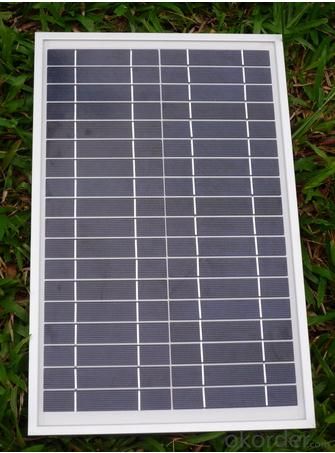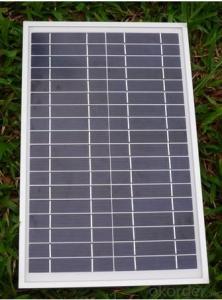.35KW CNBM Monocrystalline Silicon Panel for Home Using
- Loading Port:
- Tianjin
- Payment Terms:
- TT OR LC
- Min Order Qty:
- 100 watt
- Supply Capability:
- 1000 watt/month
OKorder Service Pledge
OKorder Financial Service
You Might Also Like
Item specifice
35KW CNBM Monocrystalline Silicon Panel for Home Using
Production description
Solar energy is radiant light and heat from the Sun harnessed using a range of ever-evolving technologies such assolar heating, photovoltaics, solar thermal energy, solar architecture and artificial photosynthesis.
It is an important source of renewable energy and its technologies are broadly characterized as either passive solar oractive solar depending on the way they capture and distribute solar energy or convert it into solar power. Active solar techniques include the use of photovoltaic systems

Feature
1.High conversion efficiencies resulting in superior power output performance.
2.Outstanding power output even in low light or high temperature conditions
3.Optimized design for ease of soldering and lamination
Physical characteristic
1. Rigorous quality control meets the highest international standards.
2. High-transmissivity low-iron tempered glass, strong aluminium frame.
3. Using UV-resistant silicon.
4. IS09001/14001/CE/TUV/UL
Packaging
26pcs in one carton 6pallets in 20foot container 14pallets in 40 foot container.
- Q:Do solar energy systems require a backup power source during outages?
- No, solar energy systems do not require a backup power source during outages. Solar panels generate electricity from sunlight and can continue to provide power even when the grid is down. However, if the solar system is grid-tied, it may shut down automatically during an outage to prevent sending electricity back to the grid, in which case a backup battery or generator can be used to provide power.
- Q:Can solar energy systems be used in powering art galleries or museums?
- Art galleries and museums can definitely utilize solar energy systems to power their establishments. In fact, there are numerous benefits associated with the use of solar power in these venues. Firstly, due to their large spaces and extensive lighting systems, art galleries and museums consume a significant amount of energy. By implementing solar energy systems, these establishments can generate a substantial amount of electricity, reducing their reliance on traditional energy sources and cutting down on operating expenses. Furthermore, incorporating solar energy aligns with the environmental values often associated with art and culture. By utilizing clean and renewable energy, art galleries and museums can greatly reduce their carbon footprint and contribute to global efforts in fighting climate change. Additionally, solar energy systems provide a reliable source of power, particularly during peak hours when galleries and museums experience a high influx of visitors. Moreover, the installation of solar panels on the rooftops of these establishments can serve as a visual representation of their commitment to sustainability, inspiring visitors to adopt similar practices in their own lives. However, it is important to consider that the feasibility of solar energy systems in art galleries or museums may vary depending on factors such as available roof space, geographical location, and specific energy requirements. Conducting a comprehensive assessment and feasibility study is vital to determine the optimal size and configuration of the solar energy system for each individual establishment. Overall, solar energy systems offer a clean, renewable, and cost-effective solution for powering art galleries and museums. Implementing these systems not only aligns their operations with sustainable practices but also reduces their environmental impact.
- Q:Can solar energy systems be used for powering electric vehicle solar charging parking lots?
- Solar energy systems are certainly capable of powering electric vehicle solar charging parking lots. The combination of solar energy and electric vehicle charging is becoming increasingly popular as a sustainable solution for transportation and energy requirements. Sunlight can be captured and converted into electricity by installing solar panels on the parking lot structure or nearby rooftops. This clean energy can then be used to power the electric vehicle charging stations located within the parking lot. By utilizing solar power, these charging stations can operate independently of the grid, reducing the reliance on fossil fuels and minimizing greenhouse gas emissions. Furthermore, solar-powered charging lots have the advantage of generating electricity during the day when the demand for charging is typically higher. This merging of solar energy systems and electric vehicle charging infrastructure is an innovative and environmentally friendly approach to powering transportation.
- Q:Can solar energy systems be used for electric vehicle charging?
- Yes, solar energy systems can be used for electric vehicle charging. Solar panels can generate electricity from sunlight, which can then be used to charge electric vehicles. This renewable energy source is environmentally friendly and can reduce dependence on fossil fuels for transportation.
- Q:What is the impact of electromagnetic interference on solar energy system performance?
- Electromagnetic interference can have a detrimental impact on the performance of a solar energy system. It can disrupt the flow of electricity, causing fluctuations in voltage and current. This interference can lead to decreased efficiency and reduced power output of the solar panels. In extreme cases, it can even cause complete system failure. Therefore, mitigating electromagnetic interference is crucial to ensure optimal performance and reliability of solar energy systems.
- Q:Can solar energy systems be used for recreational vehicles or boats?
- Yes, solar energy systems can be used for both recreational vehicles and boats. These systems are commonly used to power various appliances, charge batteries, and provide electricity for lighting and other electrical needs while on the move. Solar panels can be easily installed on the roof or any other suitable surface of the vehicle or boat, allowing for sustainable and renewable energy generation.
- Q:Do solar energy systems require batteries?
- No, solar energy systems do not necessarily require batteries.
- Q:Can solar energy systems be used for powering electric vehicle solar charging stations at highways?
- Yes, solar energy systems can certainly be used to power electric vehicle (EV) solar charging stations at highways. Solar power is a clean and renewable energy source that can be harnessed through photovoltaic (PV) panels. These panels convert sunlight into electricity, which can then be used to charge EVs. Highways are often exposed to ample sunlight, making them ideal locations for solar charging stations. By utilizing solar energy, these charging stations can operate off-grid, reducing dependence on traditional power sources and minimizing environmental impact. Additionally, solar charging stations can be installed along highways without the need for extensive infrastructure development, as they do not require connection to the electrical grid. Solar-powered EV charging stations offer several benefits. First, they provide a sustainable and carbon-free method of charging EVs, helping to reduce greenhouse gas emissions and combat climate change. Second, they contribute to the development of a decentralized energy system, as they are independent of the electrical grid. This decentralization can enhance energy security and resilience, as well as increase the overall reliability of the charging infrastructure. Moreover, solar charging stations can have economic advantages. As the cost of solar panels continues to decrease and the efficiency of PV technology improves, the installation and maintenance costs of solar charging stations are becoming increasingly competitive with traditional charging infrastructure. Furthermore, solar charging stations can generate additional revenue through excess energy production, as any surplus electricity can be sold back to the grid. In conclusion, solar energy systems are a viable and sustainable solution for powering electric vehicle solar charging stations at highways. They offer environmental benefits, promote energy independence, and can contribute to cost savings. As the adoption of EVs continues to grow, the integration of solar energy into the charging infrastructure will play a crucial role in creating a greener and more sustainable transportation system.
- Q:How do solar energy systems impact energy storage technologies?
- Solar energy systems have a significant impact on energy storage technologies by providing a clean and renewable source of electricity. These systems generate electricity during the day when the sun is shining, but often produce more energy than needed. Energy storage technologies allow excess energy to be stored and used during periods of low or no solar generation, ensuring a constant and reliable power supply. This integration of solar energy systems with energy storage technologies promotes grid stability, reduces reliance on fossil fuels, and accelerates the transition towards a sustainable energy future.
- Q:Can solar energy systems be installed on airports or transportation hubs?
- Yes, solar energy systems can definitely be installed on airports or transportation hubs. In fact, airports and transportation hubs are ideal locations for installing solar panels due to their vast open spaces and availability of sunlight. Installing solar energy systems in these areas can significantly reduce their carbon footprint, lower energy costs, and promote sustainability in the transportation sector. Additionally, airports and transportation hubs usually have large rooftops and parking areas that can accommodate solar panels, making them suitable locations for generating clean and renewable energy.
1. Manufacturer Overview |
|
|---|---|
| Location | |
| Year Established | |
| Annual Output Value | |
| Main Markets | |
| Company Certifications | |
2. Manufacturer Certificates |
|
|---|---|
| a) Certification Name | |
| Range | |
| Reference | |
| Validity Period | |
3. Manufacturer Capability |
|
|---|---|
| a)Trade Capacity | |
| Nearest Port | |
| Export Percentage | |
| No.of Employees in Trade Department | |
| Language Spoken: | |
| b)Factory Information | |
| Factory Size: | |
| No. of Production Lines | |
| Contract Manufacturing | |
| Product Price Range | |
Send your message to us
.35KW CNBM Monocrystalline Silicon Panel for Home Using
- Loading Port:
- Tianjin
- Payment Terms:
- TT OR LC
- Min Order Qty:
- 100 watt
- Supply Capability:
- 1000 watt/month
OKorder Service Pledge
OKorder Financial Service
Similar products
New products
Hot products
Related keywords




























